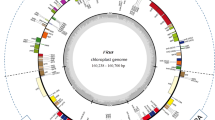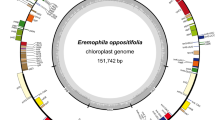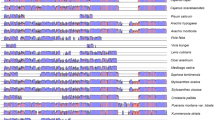Abstract
The genus Muscari Mill. (Asparagaceae Juss.) includes about 80 species distributed in Eurasia, mainly in the Mediterranean region. Recent molecular phylogenetic studies have shown that the taxa belonging to this group form a monophyletic clade and are closely related. However, the phylogeny and status of some taxa of Muscari sensu lato remain controversial. So far, most phylogenetic studies of the genus Muscari have used almost exclusively Mediterranean plant material, while representatives of the genus from the Carpathian region remain unexplored. In this work, we used the sequencing of three regions of chloroplast DNA, psbA-trnH, trnT-L, and trnL-F, to clarify the phylogenetic relationships in the genus Muscari, to assess the genetic polymorphism and taxonomic status of Ukrainian populations of M. botryoides, as well as specimens of other Muscari species from the Carpathian region. According to the results of the phylogenetic analysis, the genus Muscari is a monophyletic group that includes three subgenera: Muscari, Muscarimia, and Pseudomuscari. Leopoldia species have been placed in the subgenus Muscari. Specimens of M. botryoides from Ukraine and Austria together with M. transsilvanicum from Romania and M. serpentinicum/M. sandrasicum from Turkey form the clade “Botryoides”, one of the three main clades identified in the subgenus Muscari. A significant genetic distance between Ukrainian specimens of M. botryoides, specimens of this species from other habitats, and other species of the genus Muscari allows us to consider the Ukrainian specimens of M. botryoides as a new, previously undescribed species. A comparison of the sequences of the investigated regions of the chloroplast genome revealed genetic differences between two groups of Ukrainian populations of M. botryoides, which can be interpreted as the existence of two intraspecific forms.





Similar content being viewed by others
REFERENCES
Ali, S.S., Yu, Y., Pfosser, M., and Wetschnig, W., Inferences of biogeographical histories within subfamily Hyacinthoideae using S-DIVA and Bayesian binary MCMC analysis implemented in RASP (Reconstruct Ancestral State in Phylogenies), Ann. Bot., 2012, vol. 109, no. 1, pp. 95–107. https://doi.org/10.1093/aob/mcr274
Andrino, C.O., Sano, P.T., Inglis, P.W., Hensold, N., Costa, F.N., and Simon, M.F., Phylogenetics of Paepalanthus (Eriocaulaceae), a diverse Neotropical monocot lineage, Bot. J. Linn. Soc., 2021, vol. 195, no. 1, pp. 34–52. https://doi.org/10.1093/botlinnean/boaa070
Anisimova, M. and Gascuel, O., Approximate likelihood-ratio test for branches: a fast, accurate, and powerful alternative, Syst. Biol., 2006, vol. 55, pp. 539–552. https://doi.org/10.1080/10635150600755453
Böhnert, T., Neumann, M., Quandt, D., and Weigend, M., Phylogeny based generic reclassification of Muscari sensu lato (Asparagaceae) using plastid and genomic DNA, Taxon, 2023, vol. 72, no. 2, pp. 261–277. https://doi.org/10.1002/tax.12864
Bojnanský, V. and Fargašová, A., Atlas of Seeds and Fruits of Central and East-European Flora: the Carpathian Mountains region, Springer Sci. Business Media, 2007. https://doi.org/10.17221/18/2008-pps
Borzatti von Loewenstern, A., Giordani, T., Astuti, G., Andreucci, A., and Peruzzi, L., Phylogenetic relationships of Italian Bellevalia species (Asparagaceae), inferred from morphology, karyology and molecular systematics, Plant Biosyst., 2013, vol. 147, no. 3, pp. 776–787. https://doi.org/10.1080/11263504.2013.829884
Boychuk, S.V. and Budzhak, V.V., Modern views on phylogeny and systematic position of the genus Muscari (Asparagaceae) Miller. Scientific Herald of Chernivtsi University, Biology, 2020, vol. 12, no. 2, pp. 312–318. https://doi.org/10.31861/biosystems2020.02.312
Boychuk, S.V. and Budzhak V.V., Intraspecific taxonomy of Muscari botryoides s. l. (Asparagaceae s. l. / Hyacinthaceae s. str.): history of research and synonymy, Ukr. Bot. J., 2021, vol. 78, no. 6, pp. 407–413. https://doi.org/10.15407/ukrbotj78.06.407
Burland, T.G., DNASTAR’s Lasergene sequence analysis software, Bioinf. Methods Protoc., 1999, pp. 71–91. https://doi.org/10.1385/1-59259-192-2:71
Coissac, E., Hollingsworth, P.M., Lavergne, S., and Taberlet, P., From barcodes to genomes: extending the concept of DNA barcoding, Mol. Ecol., 2016, vol. 25, no. 7, pp. 1423–1428. https://doi.org/10.1111/mec.13549
Dashwood, M. and Mathew, B., Hyacinthaceae-little blue bulbs, in RHS Plant Trials and Awards. Bulletin Number 11, Wisley: R. Hortic. Soc., 2005.
Didukh, Y., Chervona knyha Ukrainy. Roslynnyi svit (Red Book of Ukraine. Flora), Kyiv: Hlobalkonsaltynkh, 2009.
Dizkirici, A., Yigit, O., Pinar, M., and Eroglu, H., Molecular phylogeny of Muscari (Asparagaceae) inferred from cpDNA sequences, Biologia, 2019, vol. 74, pp. 205–214. https://doi.org/10.2478/s11756-018-00164-0
Grimm, G.W., Denk, T., and Hemleben, V., Evolutionary history and systematics of Acer section Acer—a case study of low-level phylogenetics, Plant Syst. Evol., 2007, vol. 267, pp. 215–253. https://doi.org/10.1007/s00606-007-0572-8
Grundmann, M., Rumsey, F.J., Ansell, S.W., Russell, S.J., Darwin, S.C., et al., Phylogeny and taxonomy of the bluebell genus Hyacinthoides, Asparagaceae [Hyacinthaceae], Taxon, 2010, vol. 59, no. 1, pp. 68–82. https://doi.org/10.1002/tax.591008
Guindon, S., Dufayard, J.F., Lefort, V., Anisimova, M., Hordijk, W., and Gascuel, O., New algorithms and methods to estimate maximum-likelihood phylogenies: assessing the performance of PhyML 3.0, Syst. Biol., 2010, vol. 59, no. 3, pp. 307–321. https://doi.org/10.1093/sysbio/syq010
Huelsenbeck, J.P. and Ronquist, F., MRBAYES: Bayesian inference of phylogenetic trees, Bioinformatics, 2001, vol. 17, no. 8, pp. 754–755. https://doi.org/10.1093/bioinformatics/17.8.754
Ishchenko, O.O., Panchuk, I.I., Andreev, I.O., Kunakh, V.A., and Volkov, R.A., Molecular organization of 5S ribosomal DNÀ of Deschampsia antarctica, Cytol. Genet., 2018, vol. 52, no. 6.,pp. 416–421. https://doi.org/10.3103/S0095452718060105
Ishchenko, O.O., Bednarska, I.O., and Panchuk, I.I., Application of 5S ribosomal DNA for molecular taxonomy of subtribe Loliinae (Poaceae), Cytol. Genet., 2021, vol. 55, pp. 10–18. https://doi.org/10.3103/S0095452721010096
Jafari, A. and Maassoumi, A.A., Synopsis of Leopoldia, Muscari and Pseudomuscari (Hyacinthaceae) in Iran, with Leopoldia ghouschtchiensis sp. nova, Ann. Bot. Fenn., 2011, vol. 48, no. 5, pp. 396–400. https://doi.org/10.5735/085.048.0502
Katoh, K., Rozewicki, J., and Yamada, K.D., MAFFT online service: multiple sequence alignment, interactive sequence choice and visualization, Brief Bioinf., 2019, vol. 20, pp. 1160–1166. https://doi.org/10.1093/bib/bbx108
Kish, R., Chromosome numbers of bulbous monocotyledons of the Transcarpathian flora (Ukraine), Thaiszia, 2016, vol. 26, no. 1, pp. 21–26.
Kricsfalusy, V.V., Critical-systematic analysis of ephemeroid geophytes (Amaryllidales, Liliales) in the East Carpatian flora, Sci. Bull. Uzhhorod. Univ., Ser. Biol., 1999, vol. 6, pp. 21–32.
Kumar, S., Stecher, G., Knyaz, C., and Tamura, K., MEGA X: molecular evolutionary genetics analysis across computing platforms, Mol. Biol. Evol., 2018, vol. 35, no. 635, pp. 1547–1549. https://doi.org/10.1093/molbev/msy096
Marhold, K., Multivariate morphometrics and its application to monography at specific and infraspecific levels, in Monographic Plant Systematics: Fundamental Assessment of Plant Biodiversity, Ruggell: Gantner, 2011, vols. 73–99.
Mehmood, F., Ubaid, Z., Shahzadi, I., Ahmed, I., Waheed, M.T., Poczai, P., and Mirza, B., Plastid genomics of Nicotiana (Solanaceae): insights into molecular evolution, positive selection and the origin of the maternal genome of Aztec tobacco (Nicotiana rustica), PeerJ, 2020, vol. 8, p. e9552. https://doi.org/10.7717/peerj.9552
Nath, S., Sarkar, S., Patil, S.D., Saha, P.S., Lekhak, M.M., et al. Cytogenetic diversity in Scilloideae (Asparagaceae): a comprehensive recollection and exploration of karyo-evolutionary trends, Bot. Rev., 2023, vol. 89, pp. 158–200. https://doi.org/10.1007/s12229-022-09279-1
Okonechnikov, K., Golosova, O., and Fursov, M., Unipro UGENE: a unified bioinformatics toolkit, Bioinformatics, 2012, vol. 28, no. 8, pp. 1166–1167. https://doi.org/10.1093/bioinformatics/bts091
Oyundelger, K., Harpke, D., Herklotz, V., Troeva, E., and Zheng, Z., Phylogeography of Artemisia frigida (Anthemideae, Asteraceae) based on genotyping-by-sequencing and plastid DNA data: Migration through Beringia, J. Evol. Biol., 2022, vol. 35, no. 1, pp. 64–80. https://doi.org/10.1111/jeb.13960/v2/review2
Özüdoğru, B., Uler, A.D., Hacıoğlu, T.B., and Yıldırım, H., Phylogeny, biogeography, and character evolution in the genus Scilla s.l. and its close relatives Chionodoxa, Gemicia, Puschkinia, and Prospero (Asparagaceae), Plant Syst. Evol., 2022, vol. 308, no. 6, p. 44. https://doi.org/10.1007/s00606-022-01835-x
Pang, X., Liu, C., Shi, L., Liu, R., Liang, D., et al., Utility of the trnH–psbA intergenic spacer region and its combinations as plant DNA barcodes: a meta-analysis, PloS One, 2012, vol. 7, no. 11, p. e48833. https://doi.org/10.1371/journal.pone.0048833
Peregrym, M.M., Representation of bulb and bulbotuberiferous species of the natural flora of Ukraine in protected plant lists of different levels, Ukr. Bot. J., 2012, vol. 69, no. 6, pp. 832–846.
Phosser, M. and Speta, F., Phylogenetics of Hyacinthaceae based on plastid DNA sequences, Ann. Mo. Bot. Gard., 1999, vol. 86, no. 4, pp. 852–875. https://doi.org/10.2307/2666172
Porebski, S., Bailey, L.G., and Baum, B.R., Modification of a CTAB DNA extraction protocol for plants containing high polysaccharide and polyphenol components, Plant Mol. Biol. Rep., 1997, vol. 15, no. 1, pp. 8–15. https://doi.org/10.1007/BF02772108
Saha, P.S. and Jha, S., A molecular phylogeny of the genus Drimia (Asparagaceae: Scilloideae: Urgineeae) in India inferred from non-coding chloroplast and nuclear ribosomal DNA sequences, Sci. Rep., 2019, vol. 9, p. 7563. https://doi.org/10.1038/s41598-019-43968-z
Simeone, M.C., Cardoni, S., Piredda, R., Imperatori, F., Avishai, M., Grimm, G.W., and Denk, T., Comparative systematics and phylogeography of Quercus section Cerris in western Eurasia: inferences from plastid and nuclear DNA variation, PeerJ, 2018, vol. 6, p. e5793. https://doi.org/10.7287/peerj.preprints.26995v1
Somanathan, I. and Baysdorfer, C., A bioinformatics approach to identify telomere sequences, Biotechniques, 2018, vol. 65, no. 1, pp. 20–25. https://doi.org/10.2144/btn-2018-0057
Speta, F., Hyacinthaceae, in Flowering Plants Monocotyledons: Lilianae (except Orchidaceae), 1998, pp. 261–285. https://doi.org/10.1007/978-3-662-03533-7_35
Štorchová, H. and Olson, M.S., The architecture of the chloroplast psbA-trnH non-coding region in angiosperms, Plant Syst. Evol., 2007, vol. 268, no. 1, pp. 235–256. https://doi.org/10.1007/s00606-007-0582-6
Taberlet, P., Gielly, L., Pautou, G., and Bouvet, J., Universal primers for amplification of three non-coding regions of chloroplast DNA, Plant Mol. Biol., 1991, vol. 17, pp. 1105–1109. https://doi.org/10.1007/bf00037152
Tynkevich, Y.O. and Volkov, R.A., 5S ribosomal DNA of distantly related Quercus species: molecular organization and taxonomic application, Cytol. Genet., 2019, vol. 53, no. 6, pp. 459–466. https://doi.org/10.3103/S0095452719060100
Tynkevich, Y.O., Boychuk, S.V., and Chorney, I.I., Assessment of the possibility of using the chloroplast genome region psbA-trnH for the study of genetic polymorphism of Ukrainian populations of Muscari botryoides (L.) Mill. Scientific Herald of Chernivtsi University, Biology, 2022a, vol. 14, no. 2, pp. 124–128. https://doi.org/10.31861/biosystems2022.02.124
Tynkevich, Y.O., Shelyfist, A.Y., Kozub, L.V., Hemleben, V., Panchuk, I.I., and Volkov, R.A., 5S ribosomal DNA of genus Solanum: molecular organization, evolution, and taxonomy, Front. Plant Sci., 2022b, vol. 13, no. 852406. https://doi.org/10.3389/fpls.2022.852406
Vozárová, R., Herklotz, V., Kovařík, A., Tynkevich, Y.O., Volkov, R.A., Ritz, C.M., and Lunerová, J., Ancient origin of two 5S rDNA families dominating in the genus Rosa and their behavior in the Canina-type meiosis, Front. Plant Sci., 2021, vol. 12, no. 643548. https://doi.org/10.3389/fpls.2021.643548
Waterhouse, A.M., Procter, J.B., Martin, D.M., Clamp, M., and Barton, G.J., Jalview Version 2—a multiple sequence alignment editor and analysis workbench, Bioinformatics, 2009, vol. 25, no. 9, pp. 1189–1191. https://doi.org/10.1093/bioinformatics/btp033
WCSP World Checklist of selected plant families. Facilitated by the Royal Botanic Gardens, Kew, 2023. http://wcsp.science.kew.org/. Accessed March 7, 2023.
WFO World Flora Online, 2023. http://www.worldfloraonline.org/. Accessed March 7, 2023.
Funding
The study was supported by the Ministry of Education and Science of Ukraine, grant no. 0122U001335.
Author information
Authors and Affiliations
Corresponding author
Ethics declarations
The authors declare that they have no conflicts of interest. This study does not contain any investigations involving humans and vertebral animals as study objects.
About this article
Cite this article
Tynkevich, Y.O., Boychuk, S.V., Shelyfist, A.Y. et al. Molecular Phylogeny and Genetic Diversity of Carpathian Members of the Genus Muscari Inferred from Plastid DNA Sequences. Cytol. Genet. 57, 387–398 (2023). https://doi.org/10.3103/S0095452723050079
Received:
Revised:
Accepted:
Published:
Issue Date:
DOI: https://doi.org/10.3103/S0095452723050079




